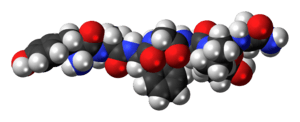Dermorphin
 | |
 | |
| Names | |
|---|---|
| Other names
Tyrosyl-alanyl-phenylalanyl-glycyl-tyrosyl-prolyl-serinamide | |
| Identifiers | |
| 77614-16-5 | |
| 3D model (Jmol) | Interactive image |
| ChEMBL | ChEMBL278789 |
| ChemSpider | 4588650 |
| PubChem | 5485199 |
| |
| |
| Properties | |
| C40H50N8O10 | |
| Molar mass | 802.89 g·mol−1 |
| Except where otherwise noted, data are given for materials in their standard state (at 25 °C [77 °F], 100 kPa). | |
| | |
| Infobox references | |
Dermorphin is a hepta-peptide first isolated from the skin of South American frogs belonging to the genus Phyllomedusa.[1] The peptide is a natural opioid that binds as an agonist with high potency and selectivity to mu Opioid receptors.[2][3] Dermorphin is about 30–40 times more potent than morphine but theoretically may be less likely to produce drug tolerance and addiction (due to its high potency).[4] The amino acid sequence of dermorphin is H-Tyr-D-Ala-Phe-Gly-Tyr-Pro-Ser-NH2.
Dermorphin is not found in humans or other mammals and similar D-amino acid peptides have only been found in bacteria, amphibians and molluscs.[5] Dermorphin appears to be made in these through an unusual posttranslational modification carried out by an amino acid isomerase.[6] This unusual process is needed because the D-alanine in this peptide is not among the 20 amino acids coded for in the genetic code and thus the peptide cannot be synthesized in the usual way from the encodings in the genome of an organism.
Illicit use
Dermorphin has been illegally used in horse racing as a performance-enhancing drug. Due to dermorphin's painkilling activity, horses treated with dermorphin may run harder than they would otherwise.[7]
See also
References
- ↑ Melchiorri P, Negri L (1996). "The dermorphin peptide family". Gen. Pharmacol. 27 (7): 1099–107. doi:10.1016/0306-3623(95)02149-3. PMID 8981054.
- ↑ Amiche M, Delfour A, Nicolas P (1998). "Opioid peptides from frog skin". EXS. 85: 57–71. doi:10.1007/978-3-0348-8837-0_4. PMID 9949868.
- ↑ Erspamer V, Melchiorri P, Falconieri-Erspamer G, et al. (1989). "Deltorphins: a family of naturally occurring peptides with high affinity and selectivity for delta opioid binding sites". Proc. Natl. Acad. Sci. U.S.A. 86 (13): 5188–92. doi:10.1073/pnas.86.13.5188. PMC 297583
 . PMID 2544892.
. PMID 2544892. - ↑ Broccardo M, Erspamer V, Falconieri Erspamer G, et al. (1981). "Pharmacological data on dermorphins, a new class of potent opioid peptides from amphibian skin". Br. J. Pharmacol. 73 (3): 625–31. doi:10.1111/j.1476-5381.1981.tb16797.x. PMC 2071698
 . PMID 7195758.
. PMID 7195758. - ↑ Kreil G (15 April 1994). "Peptides containing a D-amino acid from frogs and molluscs". J. Biol. Chem. 269 (15): 10967–70. PMID 8157620.
- ↑ Heck SD, Faraci WS, Kelbaugh PR, Saccomano NA, Thadeio PF, Volkmann RA (1996). "Posttranslational amino acid epimerization: enzyme-catalyzed isomerization of amino acid residues in peptide chains". Proc. Natl. Acad. Sci. U.S.A. 93 (9): 4036–9. doi:10.1073/pnas.93.9.4036. PMC 39482
 . PMID 8633012.
. PMID 8633012. - ↑ Bogdanich W (19 June 2012). "Turning to Frogs for Illegal Aid in Horse Races". New York Times. Retrieved 19 June 2012.